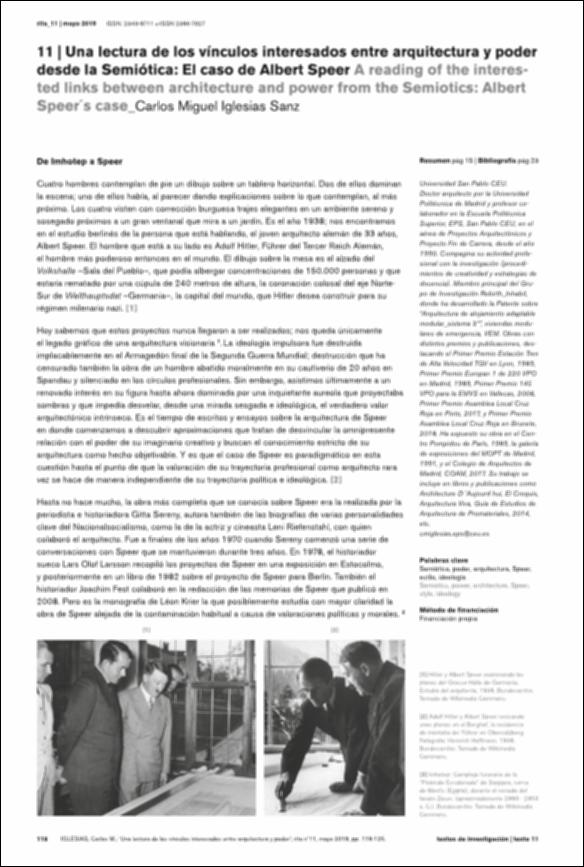Please use this identifier to cite or link to this item:
http://hdl.handle.net/10637/15955Una lectura de los vínculos interesados entre arquitectura y poder desde la Semiótica: El caso de Albert Speer
| Title: | Una lectura de los vínculos interesados entre arquitectura y poder desde la Semiótica: El caso de Albert Speer A reading of the interested links between architecture and power from the Semiotics: Albert Speer´s case |
| Authors : | Iglesias Sanz, Carlos Miguel |
| Keywords: | Semiótica; Poder (Filosofía); Arquitectura; Ideologías |
| Publisher: | Redfundamentos |
| Citation: | Iglesias Sanz, Carlos M. “Una lectura de los vínculos interesados entre arquitectura y poder desde la Semiótica: el caso de Albert Speer”, ed. Revista RITA Redfundamentos (Peris Blat, I., 2019), 118-125. https://doi.org/10.24192/2386-7027(2019)(v11)(11). |
| Abstract: | Poder y Arquitectura han establecido vínculos interesados a lo largo del tiempo, demandando
el primero, por voluntad impuesta, la manifestación iconográfica de esta
que a su vez representa en sus diferentes estilos el mensaje ideológico requerido.
El régimen nazi extremó esta alianza fáustica con una simbiosis simbólica fascinadora
en su lenguaje codificado. Albert Speer, el brillante arquitecto del Führer visionario,
quedó atrapado en esta atmósfera que cultivaba la idolatría al líder carismático
dentro de una visión totalizante. Sirvió de instrumento eficaz en la creación de la arquitectura
expresiva del político hasta el punto de lograr fijar en piedra la palabra del
poder. Proponemos una mirada desde la Semiótica, como dispositivo complementario
de análisis arquitectónico ya que no solo la arquitectura es funcionalidad, sino
también expresión, emoción, y, sobre todo, comunicación. Speer alcanza sus mayores
logros al conseguir en sus escenografías arquitectónicas un espacio cohesivo
en el que la representación del poder absoluto llega al clímax emocional común,
destinado a un público narcotizado en la fascinación colectiva. Es la semiótica, aún
con sus limitaciones en su necesidad de reestructuración continua para las descodificaciones,
donde las ideologías y la circunstancia perturban el mensaje, un eficaz
instrumento analítico, entre otros, aplicable al campo arquitectónico. Power and architecture have established interested links over time, demanding the first one, for well versed will, the iconographic manifestation of this one that in turn represents in his different styles the ideological needed message. The nazi regime was this faustian alliance with a symbolic fascinating symbiosis in their coded language. Albert Speer, the brilliant architect of the visionary Führer, was caught in this atmosphere that cultivated idolatry to the charismatic leader within a totalizing vision. It served as effective instrument for the creation of the expressive architecture of the political to the point of achieving set in stone the word of power. We propose a look from semiotics as additional device of architectural analysis since not only the architecture is a functionality, but also expression, emotion, and, especially, communication. Speer reaches his greatest achievements to get in their architectural scenery a cohesive space in which the representation of absolute power becomes common emotional climax, destined to a public narcotized in the collective fascination. It´s the semiotics, even with their limitations in their need for continued restructuring for the decodifications, where the ideologies and the circumstance disturb the message, a successful analytical instrument, among others, applicable to the architectural field. |
| URI: | http://hdl.handle.net/10637/15955 |
| Rights : | http://creativecommons.org/licenses/by-nc-nd/4.0/deed.es |
| ISSN: | 2340-9711 |
| Issue Date: | May-2019 |
| Center : | Universidad San Pablo-CEU |
| Appears in Collections: | Escuela de Politécnica Superior |
Items in DSpace are protected by copyright, with all rights reserved, unless otherwise indicated.


